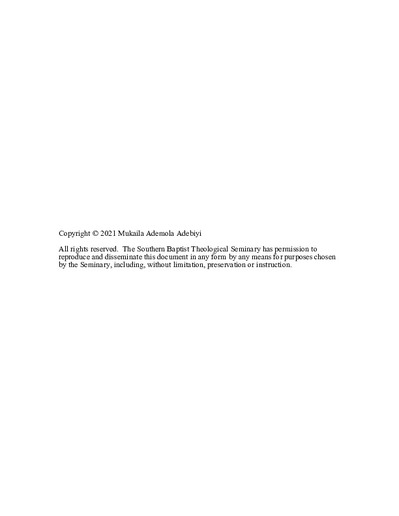Equipping Pastors in Union Baptist Association, Jos, Nigeria, to Teach Adoption As a Viable Ministry for Infertile Couples
Subject
Adoption--Biblical teachingAdoption--Religious aspects--Christianity
Children--Nigeria
Infertility--Nigeria
Adoption--Nigeria
Abstract
The purpose of this project was to biblically and theologically equip pastors in the Union Baptist Association, Jos, Nigeria, to teach adoption of children as a viable ministry option to infertile couples for care of orphans, satisfaction of parental instinct, and the fulfillment of the Great Commission to the glory of God. Chapter 1 presents the context, rationale, purpose, goals, research methodology, definitions, delimitations, and limitations of this project.
Chapter 2 explains the biblical and theological basis of children adoption. The examples of physical adoptions and images of adoption in the Old Testament were examined in great deal. The fact of Israel’s adoption by God is a major theme in the Old Testament. Adoption of Jesus by Joseph is the only case of physical adoption in the New Testament. This chapter explains further that though many New Testament writers allude to the concept of adoption in their writings, only apostle Paul employed a technical term to describe this concept. Pauline huiothesia is influenced by both Judaism that provided Paul with history and theology for the term, and Paul’s affiliation with Greco-Roman culture, which gave him physical example and terminology. Finally, this chapter explains how James 1: 27 is the key New Testament scripture that gives support to physical adoption of children.
Chapter 3 addresses reasons why adoption is not well practiced in Nigeria. Socio-cultural consideration is the main obstacle against child adoption in southern Nigeria, while the influence of Islamic religion is the main factor militating against children adoption in northern Nigeria. Islam forbids child adoption.
Chapter 4 describes the details of the project implementation—development of the seminar sessions, implementation of the seminar, collation of the pre- and post-seminar surveys, and the processing of the data. Finally, chapter 5 states the evaluations of the purpose and goals of the project and suggestions for future improvement.

